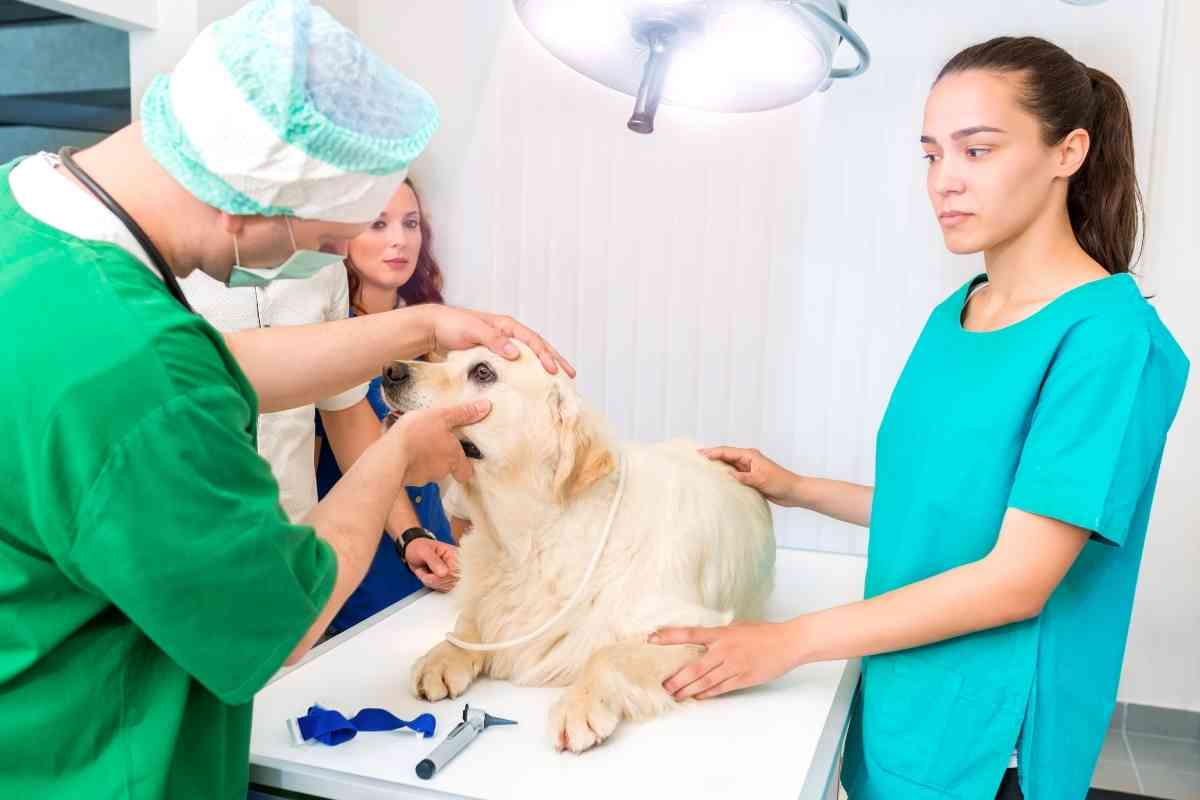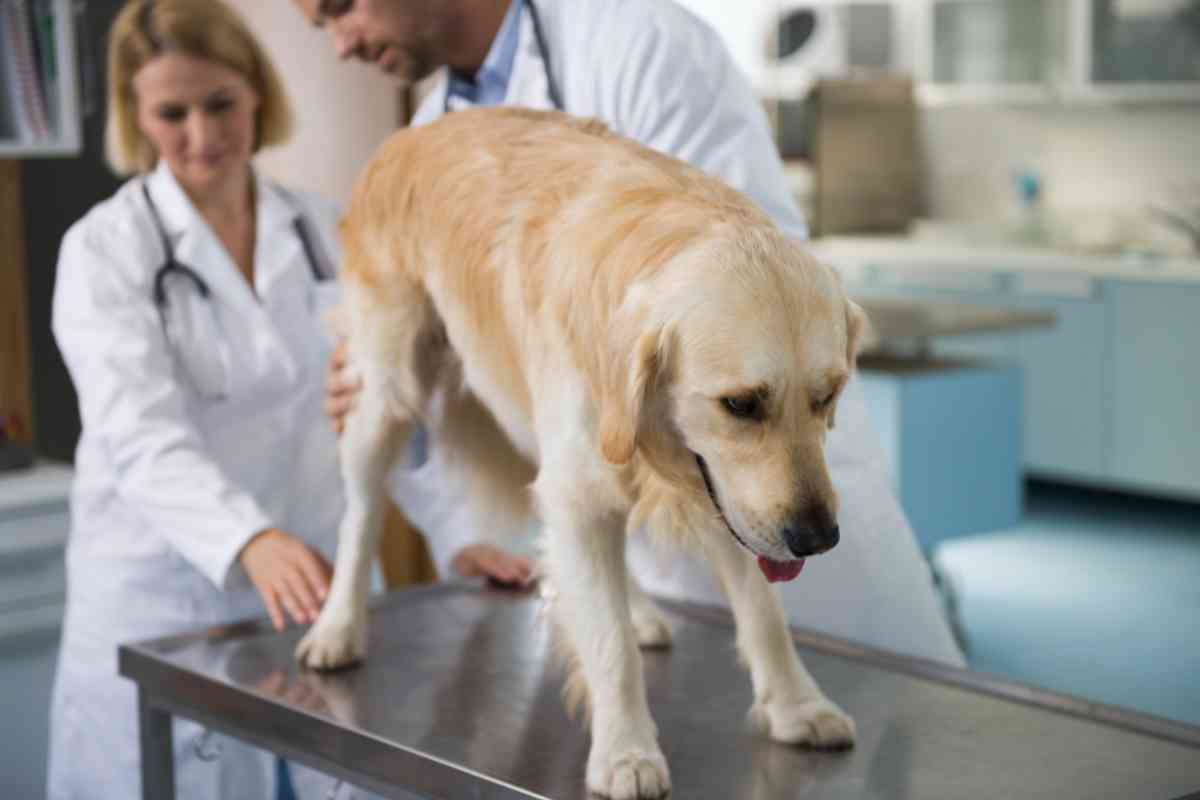What Illnesses Are Golden Retrievers Prone To Get?
Do you own a Golden Retriever? There are a few health conditions that you need to know about and what symptoms your Golden Retriever will show if they have them. Doing so is the only way to responsibly care for your Golden Retriever and ensure that they live a long and healthy life.
Still, though, even with the best care in the world, Golden Retrievers are known to commonly develop a few health problems.
Knowing the signs and symptoms can help you detect any issues early and start treatment right away so that your dog can have a long and healthy life.
What Illnesses Are Golden Retrievers Prone To Get?
The three most common illnesses that Golden Retrievers are prone to getting are cancer, usually of the blood, lymph, or bones; dilated cardiomyopathy, which affects their hearts; and hip dysplasia. Each of these common illnesses will show different symptoms in your Golden Retriever, so pet parents need to know what symptoms to look for.
While there are signs and symptoms that you need to know to look for as well as things you can do to help prevent these diseases.
Even if your Golden Retriever currently seems perfectly healthy, it’s important for you to be aware of the signs of these common illnesses so you are prepared to spot them and act immediately if your Golden Retriever does end up getting sick.
Read on for detailed information about Golden Retrievers and cancer, cardiomyopathy, and hip dysplasia, as well as some common and not-so-common treatment options.
Cancer

Golden Retrievers are one of the most common breeds of dogs that can get cancer.
The most common types of Cancer seen in Golden Retrievers are:
- Hemangiosarcoma
- Lymphoma
- Osteosarcoma
Hemangiosarcoma
Hemangiosarcoma is a type of malignant cancer seen in your Golden Retriever’s blood vessels.
The blood vessels can be located anywhere in your dog’s body, including the skin and major internal organs.
The most common sites for hemangiosarcoma to be seen are the spleen, heart, and liver.
Hemangiosarcoma is the most common type of splenic tumor in dogs and is especially common in Golden Retrievers.
This type of cancer is usually locally aggressive and highly metastatic, meaning it will easily and quickly spread to other organs.
What causes hemangiosarcoma in Golden Retrievers?
The cause of hemangiosarcoma in dogs is unknown.
It is thought that it may be caused by sunlight exposure if the mass occurs on the skin.
Golden Retrievers are one of the common breeds that are predisposed to Hemangiosarcoma.
Hemangiosarcoma is mostly seen in older Golden Retrievers usually over 8 years old. Hemangiosarcoma can also be seen in smaller and even younger dogs, too but is far more common in large older breed dogs.
Signs of Hemangiosarcoma in Golden Retrievers
There are many signs that your vet would be looking at to indicate that your Golden Retriever may have hemangiosarcoma.
The common signs that your Golden Retriever may have hemangiosarcoma are:
- Enlarged abdomen
- Pale white gums
- Lethargic
- Unexplained weight loss
- Decrease exercise
- Panting
- Decrease appetite
- Collapse
If your Golden Retriever has hemangiosarcoma on their skin, you may see a small red bump that looks like a blood blister.
These are usually less than ½ an inch in size and may bleed very easy when you touch them.
If you notice any of these signs in your Golden Retriever, it would be the best to take them to the vet right away.
Your vet will be able to fully examine your dog and see if they also think that your dog has hemangiosarcoma or if they have another disease, causing them to have these signs and symptoms.
How is Hemangiosarcoma diagnosed?
There are many different things that your vet may do to help them diagnose your dog with hemangiosarcoma.
The only way to tell for sure if your dog does have hemangiosarcoma is to take a sample of the mass and send it to a veterinary pathologist for review.
The pathologist will take a thin slice of the mass and look for signs of cancer under the microscope.
There are blood test and non-invasive procedures that would also lead your vet to think that your Golden Retriever may have hemangiosarcoma. These tests are:
- CBC and Blood Chemistry Panel: this would show that your dog has a low red blood cell count. This would indicate that your dog may have a mass inside that is bleeding.
- Radiographs: Your vet may take x rays of your dog’s abdomen or chest and see a mass on the liver or spleen.
- Abdominal Ultrasound: Your vet can ultrasound your dog’s abdomen to see if there is a mass on the liver or spleen. This will also help them determine if this mass is bleeding into your dog’s abdomen.
- FNA and cytology. If your vet can get a good view of the mass with the ultrasound, they can stick a small needle into the mass and take a few cells. Your vet can look at these cells under the microscope to see if they see cells that have cancerous properties
- Biopsy. The best way to tell if your dog has hemangiosarcoma is to do surgery to remove the mass and send it to a veterinary pathologist. While this is the most invasive and most expensive way to tell what type of tumor your dog has, it is the most accurate
Stages of hemangiosarcoma in Golden Retrievers
There are different stages of hemangiosarcoma in Golden Retrievers.
This depends on how aggressive the tumor is and where it has spread to in your dog’s body.
These are the three stages of hemangiosarcoma in dogs:
- Stage 1: The mass is only in the spleen
- Stage 2: The splenic mass is ruptured with local lymph node involvement
- Stage 3: The mass has spread to distant lymph nodes
The more aggressive the mass is, the higher the grade—also, the higher the grade, the worse the prognosis and life expectancy for your Golden Retrievers.
Does Hemangiosarcoma cause your Golden Retrievers to be pain?
Usually, this type of tumor can cause your dog to be lethargic and have to undergo very invasive surgery. This type of surgery may be painful.
Your vet will make sure that your dog has pain medication to help keep them comfortable while they are recovering from surgery.
Golden Retrievers who have an internal mass may be painful from the bloated and distended abdomen.
These masses will take up space in your dog’s abdomen and can cause them to be more uncomfortable when they are walking or lying down.
If you notice that your Golden Retriever is more painful, it would be best for your vet to examine your Golden Retrievers to figure out what is causing this abdominal pain.
How is hemangiosarcoma treated?
There are many different treatments for hemangiosarcoma. Surgery and/or chemotherapy are usually used in treating hemangiosarcoma.
Surgery
A splenectomy is the treatment of choice for hemangiosarcoma in the spleen, the main organ affected by this type of cancer.
Depending on how involved the mass is, other organs can be partially removed.
Your Golden Retrievers can live without part of their liver, and if only a certain part is effective, it can easily be removed.
Chemotherapy
Chemotherapy is usually used after splenectomy to help prevent or treat any part of a tumor that has spread to other organs in the body.
With the use of chemotherapy and surgery, you can help increase the survival time in Golden Retrievers with hemangiosarcoma.
The majority of dogs will tolerate chemotherapy very well and will maintain a good to excellent quality of life even during chemotherapy treatment.
A drug called doxorubicin is the most commonly used chemotherapy drug to treat Golden Retrievers with hemangiosarcoma.
Your dog will receive a chemotherapy injection every three weeks for 5 to 6 dosages. This is usually started a few weeks after surgery.
This is a medication that has to go in your Golden Retriever’s vein, so they most likely will need to spend the day at the vet clinic.
Some chemotherapy is only done by a veterinary oncologist. So, your vet may refer your dog to a veterinary oncologist for their chemotherapy treatment.
A veterinary oncologist has had specialized training beyond veterinary school to help them treat and manage cancers.
There are other chemotherapy drugs that can be used to treat your Golden Retrievers with hemangiosarcoma.
Your vet can determine the best route of treatment.
Many people think of chemotherapy in the Golden Retrievers as the same as in people, but this is actually very different.
Most dogs do not have the same side effects that we think of with people because the dosages are not as high.
Discuss the pros and cons of the different chemotherapy options with your vet.
What Supplement will help My Golden Retriever with hemangiosarcoma?
There are some supplements that you can give to your Golden Retrievers to help them with hemangiosarcoma.
Many of the supplements are being studied at many veterinary schools in the US.
These are some common supplements that your veterinarian may prescribe for your Golden Retrievers to take.
I’m Yunity Polysaccharopeptide (PSP) mushrooms
These are Asian mushrooms that are mixtures of mushroom-derived polysaccharides.
The bioactive agent is from mushroom Coriolus Versicolor, but the brands are proprietary blends.
These mushrooms cause the cancer cells to die and have other anti-cancer properties.
A study done at the University of Pennsylvania has shown that giving dogs these mushrooms after splenic removal will help increase the survival time.
Golden Retriever’s survival rate increase from 86 days to 199 days.
Yunnan Baiyao
This is a Chinese herbal root mixture. Yunnan Baiyao claims to decrease bleeding and has hemostatic properties, activates platelets, and decreases bleeding and clotting times.
Yunnan Baiyao is one of the most popular Chinese herbs used in veterinary medicine for hemorrhage.
It is known to stop bleeding anywhere within the body.
It has even been shown to decrease clotting times and initiate the release of platelets.
Platelets are responsible for clot formations in your Golden Retrievers’ body.
The recommended dose for hemangiosarcoma is 60-75 mg/kg daily or 1/4 tsp. per 10 -15 pounds divided twice a day.
There are many other supplements that are currently being studied, and hopefully, in the near future, there are many other treatment choices that will increase the survival time and quality of life for Golden Retrievers with hemangiosarcoma.
What is the prognosis and life expectancy for hemangiosarcoma?
The prognosis for hemangiosarcoma with surgery alone is poor.
The median survival time in Golden Retrievers treated with only surgery is 1 to 3 months, and less than 10% of dogs will survive one year.
Chemotherapy improves the survival time to 6 months, using a doxorubicin-based protocol.
Low-grade tumors may have a better prognosis, especially when chemotherapy is given after surgery.
Lymphoma

Lymphoma is a type of cancer of the lymphatic system. This type of cancer causes the lymph nodes in your Golden Retriever’s neck, and legs to become enlarged.
There are even lymph nodes in your Golden Retrievers chest and abdomen that can also be affected.
Golden Retrievers who have lymphoma can undergo chemotherapy to help extend their life.
Most vets will recommend the CHOP protocol which is a different chemotherapy drug each week to help shrink the size of their lymph nodes.
Osteosarcoma
This is a type of bone cancer.
It commonly affects the wrist, shoulder, and knee. If your dog does have osteosarcoma, you will notice swelling of the bone in that location, limping and pain in their joints.
Your vet can take an x-ray to see if your dog does have bone cancer or if there is something else causing these signs.
If your Golden Retriever does have bone cancer, the gold standard treatment is amputation of the affected leg and chemotherapy.
With aggressive treatment, the prognosis is only about 1 year.
With Just amputation alone most dogs will survive for about 6 months. With no treatment at all most dogs only live for 2 to 3 months past diagnosis.
Cardiomyopathy
Large breed dogs are prone to heart issues. Golden Retrievers can commonly develop Dilated Cardiomyopathy (DCM).
This develops when the heart is not functioning properly. It causes the heart walls to dilate and become thin, leading to even more heart issues.
In turn, this causes the heart to become enlarged.
If your Golden Retriever has heart issues, you may notice these signs:
- Coughing
- Exercise intolerance
- Excessive panting
- Sudden collapse after exercise
If you notice any of these issues with your Golden Retriever, it would be best for you to see your vet right away.
DCM can be life-threatening or cause your Golden Retriever to have a shortened life.
Your vet will want to run some tests to figure out why your dog is showing these signs.
How to diagnose heart disease in your Golden Retriever
If your vet suspects that your Golden Retriever has heart issues, they will want to run these tests.
- Chest X rays: This helps assess the overall size of your dog’s heart and make sure that there is nothing else in their lungs that causes these issues.
- Echocardiogram: This is an ultrasound of your dog’s heart to assess the thickness of the walls of the heart and see how it is functioning.
- EKG: This assesses the electrical activity of your dog’s heart. This will help tell your vet how effectively your dog’s heart is beating.
Treating and Prognosis of Heart Disease in Golden Retrievers
Once your vet has figured out what is going on with your Golden Retriever’s heart, they can start medications to help your dog’s heart function more correctly.
While most heart diseases cannot be reversed, there are medications that can be given to your Golden Retriever to help slow the progression and help their heart function better.
Hip Dysplasia
Hip Dysplasia is defined as the looseness or instability of your Golden Retriever’s hip joint.
This is a common genetic condition that is seen in Golden Retrievers and usually progresses as your dog gets older.
This disease is more often observed in large and giant breed dogs such as Golden Retrievers.
Small dogs can develop hip dysplasia, but this is not very commonly seen.
What Causes Hip Dysplasia in Golden Retrievers?
One of the most common causes of hip dysplasia seen in a Golden Retriever is genetics. Most Golden Retriever who has hip dysplasia their parents and grandparents also had the disease.
Other causes of hip dysplasia are due to improper nutrition, being overweight, and too much or too little exercise.
How Do You Diagnose Hip Dysplasia In Golden Retrievers?
There are many different ways for your vet to diagnose hip dysplasia in Golden Retriever.
If your Golden Retriever is young and has a genetic line that is known for having hip dysplasia, it is best to have their hips evaluated by your vet at a young age as there are some preventive options that can be done in young Golden Retriever to decrease the severity of hip dysplasia.
Symptoms Of Hip Dysplasia
While Golden Retrievers may show a variety of symptoms, most people will notice that their Golden Retriever is now limping more than they normally do.
They may also have issues standing after laying down for a long period of time or loss in the muscle in their hips and back legs.
These are all signs that would warrant an examination by your veterinarian to see if your Golden Retriever suffers from hip dysplasia.
How will my vet diagnoses Hip Dysplasia in my Golden Retriever?

Your veterinarian will fully examine your Golden Retriever to diagnoses hip dysplasia. They will also want to take radiographs of your Golden Retriever’s hips.
These radiographs will show how well the femur (the long bone in the leg) fits into the hip socket.
Golden Retrievers with hip dysplasia, the head of the femur will barely fit into the hip socket and can usually be pushed out of place.
They may also need to sedate your dog to be able to manipulate their hips to see if they do have hip dysplasia.
How to Prevent Hip Dysplasia in Golden Retrievers
Young Golden Retriever puppies should have their hips evaluated around 2-3 months of age.
These radiographs can be sent off to a radiologist to be evaluated to see if your Golden Retriever is predisposed to developing hip dysplasia.
If they are predisposed, then there maybe surgical options that can be done to decrease the severity of the disease.
What are the Treatment Options For Hip Dysplasia in Golden Retrievers?
While there are many different ways that you can treat Hip Dysplasia in Golden Retrievers. These are some common things that you can do to help your Golden Retriever.
Give them plenty of Exercise
Exercise will greatly help strengthen your Golden Retrievers muscles around the hip joints.
It is best to do low-impact workouts such as swimming in a pool or lake. This will really help strengthen the muscles and joints.
Change Their Diet
Most dog food companies offer a diet formulation aimed at helping the dog’s joints.
These diets are usually very high in Omega 3’s, Glucosamine and Chondroitin.
These three ingredients have been shown to help decrease joint pain and help your Golden Retriever with mobility.
Surgery options for Hip Dysplasia
There are 4 different surgical procedures that your vet can do to help with hip dysplasia in your Golden Retriever.
In puppies, there are two different procedures can be done.
This all depends on the age of your Golden Retriever.
- A Juvenile Pubic Symphysiodesis (JPS) is done in puppies under 4 months of age. This procedure causes the pubic symphysis, the tissue between both sides of the pelvis, to fuse together earlier. This fusion will alter the conformation of the pelvis and will increase the coverage of the femur in the hip joint.
- A Double or Triple Pelvic Osteotomy (DPO/TPO) is done in puppies around 8 to 10 months old. This procedure you cut the pelvis and rotate the pieces to help with the confirmation of the hip joint.
- A Total Hip Replacement can be done just like it is done in people to fix the whole problem. This is the most expensive way for you to fix hip dysplasia it is the Gold Standard recommendation for hip dysplasia.
- Femoral Head and Neck Ostectomy (FHO) can be done if a total hip replacement is not a feasible expense for your dog. In an FHO the head and neck of the femur are removed, and soft tissue will for a fake joint allowing your dog to walk normal and pain-free.
How to Help your Golden Retriever with the Pain from Hip Dysplasia?
While surgical correction may not always be an option there are many ways to help your Golden Retriever with comfort from the pain.
Things like Non-Steroidal Anti-inflammatory Drugs (NSAIDs) can be prescribed by your vet to help decrease the pain and inflammation
Final Thoughts
If you have a Golden Retriever, you need to know what diseases they can possibly get so that you know what signs you need to look out for.
If your Golden Retriever seems ill at all, it would be best for your Golden Retriever to see your vet.
Many times, the quicker that you detect that something is wrong and the early that treatment is started the better the outcome.
When looking for a new Golden Retriever puppy, there are a few genetic tests that you can ask about to see if your puppy is suspectable to these diseases.
The breeder will easily be able to let you know if the parent had any health issues that you would also need to be worried about in your new Golden Retriever puppy.







